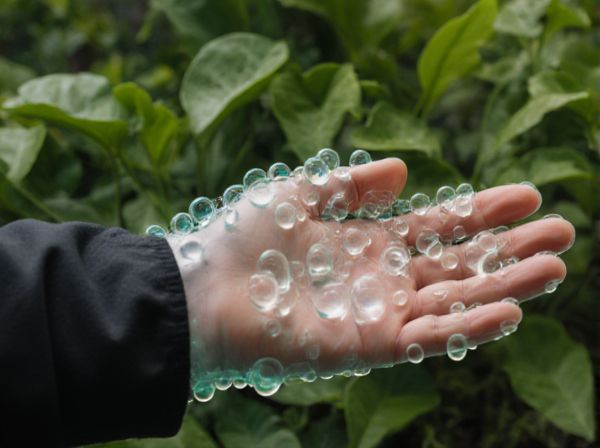
Hydrogel crystals vs Pebble mulch Illustration
Hydrogel crystals retain water within the soil, releasing moisture slowly to plant roots and reducing the frequency of watering. Pebble mulch acts as a physical barrier on the soil surface, minimizing evaporation and helping maintain consistent soil temperature. Combining hydrogel crystals with pebble mulch enhances water retention efficiency and promotes healthier plant growth.
Table of Comparison
| Feature | Hydrogel Crystals | Pebble Mulch |
|---|---|---|
| Water Retention | Absorbs and stores water, releasing it slowly to roots | Reduces evaporation by covering soil surface |
| Effect on Soil | Improves soil moisture consistently | Prevents soil erosion and compaction |
| Longevity | Lasts up to 3-5 years before degrading | Permanent, requires minimal replacement |
| Installation | Mixed into soil near roots | Laid on soil surface as a layer |
| Cost | Moderate to high initial cost | Variable cost depending on stone type and quantity |
| Best Use | Drought-prone areas needing consistent moisture | Landscapes requiring decorative ground cover and moisture control |
Introduction to Hydrogel Crystals and Pebble Mulch
Hydrogel crystals are superabsorbent polymers that retain large amounts of water, releasing it slowly to plant roots and enhancing soil moisture retention during dry periods. Pebble mulch consists of small stones spread on the soil surface, reducing evaporation and moderating soil temperature while preventing weed growth. Both methods improve water efficiency but utilize distinct mechanisms: hydrogel crystals act within the soil to store moisture, whereas pebble mulch acts as a physical barrier on the soil surface.
How Hydrogel Crystals Work for Plant Watering
Hydrogel crystals absorb and retain water up to 400 times their weight, releasing moisture slowly to plant roots, enhancing water efficiency in soil. This controlled hydration reduces the frequency of watering and prevents overwatering stress by maintaining consistent soil moisture levels. Unlike pebble mulch, hydrogel crystals directly improve water availability within the root zone rather than just reducing surface evaporation.
Pebble Mulch: Function and Water Retention
Pebble mulch enhances soil water retention by reducing evaporation and moderating soil temperature, creating a stable moisture environment for plant roots. Unlike hydrogel crystals, which absorb and release water within the soil matrix, pebble mulch forms a physical barrier that limits direct sun exposure and wind impact on the soil surface. This method effectively conserves water in drought-prone gardens, promoting healthier plant growth with less frequent irrigation.
Water Efficiency Comparison
Hydrogel crystals absorb and retain up to 400 times their weight in water, releasing moisture slowly to plant roots and significantly reducing water runoff and evaporation. Pebble mulch primarily reduces surface evaporation but does not store water, providing less overall water retention compared to hydrogels. Studies show hydrogel use can improve irrigation efficiency by up to 30%, while pebble mulch offers around a 10-15% improvement in water conservation.
Impact on Soil Health and Structure
Hydrogel crystals enhance soil moisture retention by absorbing and slowly releasing water, which promotes root growth and reduces soil compaction. Pebble mulch improves soil structure by preventing erosion and moderating soil temperature, yet it does not directly contribute to moisture retention like hydrogels. Both methods impact soil health differently: hydrogels increase water availability, while pebble mulch maintains soil stability and aeration.
Suitable Plants for Hydrogel Crystals vs Pebble Mulch
Hydrogel crystals are ideal for water-sensitive plants such as seedlings, potted plants, and succulents that require consistent moisture retention without waterlogging. Pebble mulch suits drought-tolerant plants like lavender, rosemary, and cacti, as it aids in reducing surface evaporation and maintaining soil temperature. Both methods enhance water efficiency, but plant compatibility varies based on their moisture and drainage needs.
Application Methods and Best Practices
Hydrogel crystals absorb and retain water, releasing it gradually to plant roots, making them ideal for incorporation directly into the soil before planting for sustained moisture. Pebble mulch works as a surface layer that reduces evaporation and soil temperature fluctuations, best applied around established plants while keeping a gap at the stem to prevent rot. For optimal watering efficiency, combine hydrogel crystals during soil preparation with pebble mulch to protect moisture on the surface and enhance overall water retention.
Durability and Maintenance Requirements
Hydrogel crystals absorb and retain water, releasing it slowly to plants, but they tend to degrade over a few growing seasons and require periodic replacement to maintain effectiveness. Pebble mulch offers long-lasting durability, often lasting several years without significant breakdown, reducing the need for frequent maintenance or replenishment. Maintenance for hydrogel involves monitoring soil moisture and refilling crystals, while pebble mulch requires minimal upkeep mainly to remove debris or redistribute stones.
Cost Analysis: Hydrogel Crystals vs Pebble Mulch
Hydrogel crystals typically incur higher upfront costs due to their synthetic material and specialized production process, whereas pebble mulch offers a more affordable initial investment sourced from natural stones. Over time, hydrogel crystals may reduce watering frequency by retaining moisture up to 400 times their weight, potentially lowering water bills, while pebble mulch primarily minimizes evaporation but requires regular replenishment to maintain effectiveness. Considering lifespan, pebble mulch can last several years with minimal degradation, contrasted with hydrogels that may degrade or lose efficacy within one to two growing seasons, impacting long-term cost efficiency.
Environmental Impacts and Sustainability
Hydrogel crystals absorb and retain water, reducing irrigation frequency and minimizing water runoff, which supports sustainable water use in drought-prone areas. Pebble mulch, made from natural stones, decreases soil evaporation and prevents erosion without releasing chemicals, promoting long-term soil health. Both methods reduce water waste, but hydrogel crystals are synthetic and may degrade slowly, whereas pebble mulch is more environmentally neutral and reusable.
Hydrogel crystals vs Pebble mulch Infographic

 gardendif.com
gardendif.com